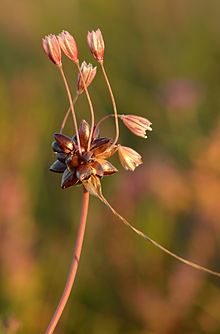Allium oxypetalum
| Field garlic | |
|---|---|
 |
|
| Allium oleraceum | |
| Scientific classification | |
| Kingdom: | Plantae |
| Clade: | Angiosperms |
| Clade: | Monocots |
| Order: | Asparagales |
| Family: | Amaryllidaceae |
| Subfamily: | Allioideae |
| Genus: | Allium |
| Species: | A. oleraceum |
| Binomial name | |
|
Allium oleraceum L. 1753 not Des Moul. 1840 |
|
| Synonyms | |
|
Synonymy
|
|
Allium oleraceum (field garlic) is a Eurasian species of wild onion. It is a bulbous perennial that grows wild in dry places, reaching 80 centimetres (31 in) in height. It reproduces by seed, bulbs and by the production of small bulblets in the flower head (similarly to Allium vineale). Unlike A. vineale, it is very rare with A. oleraceum to find flower-heads containing bulbils only. In addition, the spathe in A. oleraceum is in two parts.
Allium oleraceum is widespread across most of Europe, with additional populations in Turkey and the Caucasus. It is sparingly naturalised in scattered locations in North America.
In the United Kingdom, A. oleraceum is found in dry, grassy places, usually steeply sloping and calcareous soils, and on open sunny banks in river floodplains. It favours altitudes of 0–365 m. A. oleraceum is scattered throughout England and very scattered in Wales, Scotland and Ireland (Stace, 1997). Erosion of coastal areas leads to a reduction in the available habitat for this species, leading to population declines.
Allium oleraceum subsp. girerdii, now called Allium oporinanthum
This plant prefers partial or full exposure to sunlight. Allium oleraceum tends to grow in slightly moist, heavy clay-like soil, although it will grow just fine in other soils. This plant spreads quickly, much like a weed, and can be difficult to get rid of.
...
Wikipedia
